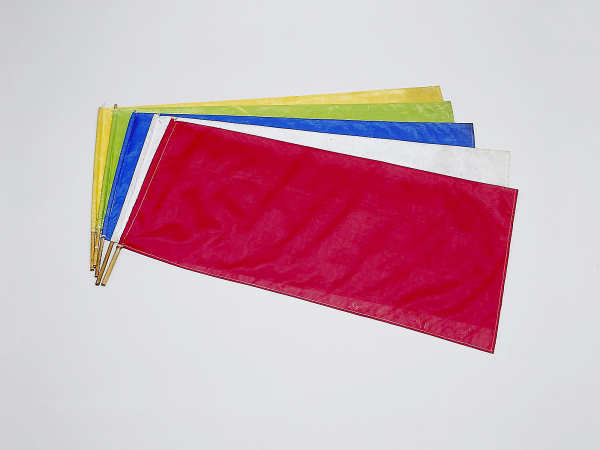한국무속신앙사전
무당이 굿에서 사용하는 다섯 색깔의 깃발로 주로 운수를 점치는 무구. 오방신장기는 신장거리에서 사용되지만 대감거리와 [장군](/topic/장군)거리 등에서도 사용하기 때문에 대감기 또는 장군기라고도 한다.
definition | 무당이 굿에서 사용하는 다섯 색깔의 깃발로 주로 운수를 점치는 무구. 오방신장기는 신장거리에서 사용되지만 대감거리와 [장군](/topic/장군)거리 등에서도 사용하기 때문에 대감기 또는 장군기라고도 한다. |
|---|---|
mp3Cnt | 0 |
wkorname | 천진기 |
| 정의 | 무당이 굿에서 사용하는 다섯 색깔의 깃발로 주로 운수를 점치는 무구. 오방신장기는 신장거리에서 사용되지만 대감거리와 [장군](/topic/장군)거리 등에서도 사용하기 때문에 대감기 또는 장군기라고도 한다. | Obangsinjanggi es el término que se refiere a las banderas de los dioses guardianes de las cinco direcciones, es una serie de banderas de cinco colores utilizadas para la adivinación en los rituales chamánicos. El palo de bandera se hace con bambú de aproximadamente 70 y 100 centímetros de largo, mientras las banderas son de seda u otra tela, a veces papel de morera teñido, que miden 70 centímetros de ancho y 50 centímetros de largo. Los colores de las banderas se asocian con las cinco direcciones según la cosmología tradicional: el color azul es para el este simbolizando la desgracia y desastres; el color blando es para el oeste simbolizando el dios celestial, [[Cheonsin](/topic/RitualdeNuevasOfrendas)](/topic/Cheonsin) o la bendición para los muertos; el color rojo es para el sur simbolizando la buena fortuna; el color negro es para el norte simbolizando la muerte; y el color amarillo es para el centro que representa a los ancestros. En el segmento de los dioses guardianes de cinco direcciones llamado sinjanggeori de un ritual chamánico, el chamán enrolla las cinco banderas juntas y su creyente recoge uno de sus mástiles para adivinar su fortuna dependiendo del color de la bandera que él mismo seleccione. La bandera roja brinda la buena fortuna y poseciones materiales, por lo que es aquellos que quieren averiguar qué va a pasar en el futuro durante el ritual de la buena fortuna llamado jaesugut suelen querer recoger dicha bandera de color rojo. La bandera blanca y la amarilla se consideran también auspiciosas; la negra y la azul, ominosas. Las obangsinjanggi tienen las funciones no solo como un medio de adivinación, sino también como un instrumento para mantener alejados los malos espíritus y fantasmas malignos. En el ritual de la iniciación chamánica llamado naerimbut, el chamán roza el cuerpo del chamán poseído que es su hijo espiritual con dichas banderas. Además, en el ritual de la curación llamado byeonggut, el chamán golpea ligeramente el cuerpo del paciente con las banderas de cinco colores para eliminar el fantasma que ha causado la enfermedad. | 巫师举行[巫祭](/topic/巫祭)时使用的五色旗子,是用于占卜的巫祭用具。 “五方神将旗”旗杆多为竹子,长约70 厘米,最长则超过100 厘米。旗面采用绸布等布料制作,有时也会采用印染的韩纸。旗面尺寸通常为长70 厘米左右,高50 厘米左右。 五方神将旗的五色与五个方位有关,分别代表东西南北中。蓝为东,象征忧患;白为西,象征天神或冥福;红为南,象征运气;黑为北,象征死亡;黄为中,象征[祖先](/topic/祖先)。 巫女举行神将祭程时,将五方神将旗卷成一团使信徒分不清颜色,之后将把手一侧伸向信徒令其挑选其中一面,并根据旗子的颜色进行占卜。挑选红色旗子被认为财运好,因此在“[利市巫祭](/topic/利市巫祭)”中人们偏好红色,挑选白色或黄色旗子也被认为是吉祥的,而挑选黑色或蓝色旗子则被认为不吉祥。 除占卜功能外,五方神将旗还具有驱逐[杂鬼杂神](/topic/杂鬼杂神)的功能。[降神](/topic/降神)巫祭中神母用五方神将旗扫过[神女](/topic/神女)身体以及在祛病巫祭中用五方神将旗拍打患者身体均可视为驱逐杂鬼杂神的行为。 | Obangsinjanggi, or the banners of the guardian gods of the five directions, is a set of banners in five colors, used for divination in shamanic rituals. These flags are made with bamboo staffs around 70 centimeters long, some as long as 100 centimeters, the banner with silk or other fabric, sometimes dyed mulberry paper. They are around 70 centimeters in width and 50 centimeters in length. The colors of the banners are associated with the five directions according to traditional cosmology: blue is for the east, and symbolizes misfortune and distress; white is for the west, symbolizing [[Cheonsin](/topic/NewOfferingsRitual)](/topic/Cheonsin) (Celestial God) or blessing for the dead; red for the south, symbolizing good fortune; black for the north, symbolizing death; and yellow for the center, which stands for one’s ancestors. In the five-direction guardian gods segment (sinjanggeori) of a shamanic ritual, the shaman rolls up the five banners together, and the followers pick one of the staffs to have one’s fortunes told. The red banner brings good fortune and material gain, which make it the most favored pick in the good-fortune ritual jaesugut. White and yellow banners are also considered auspicious; black and blue banners ominous. Obangsinjanggi functions not only as a divination tool but for chasing away evil spirits and ghosts: In the possession ritual naerimgut, the shaman brushes the body of her spiritual daughter, the possessed shaman, with these banners; and in the healing ritual byeonggut, the shaman uses the banners to pound on the patient’s body. | 내용 | 오방신장기의 색깔은 다섯 방위와 관련이 있다. 동서남북과 중앙을 각각의 색깔로 상징한다. 동쪽은 파란색으로 우환(憂患)을 상징하며 동방청제신장이라고 한다. 서쪽은 흰색으로 천신(天神) 혹은 명복(冥福)을 상징하며 서방백제신장이라 한다. 남쪽은 빨간색으로 재수(財數)를 상징하며 남방적제신장이라 한다. 북쪽은 검은색으로 죽음을 상징하며 북방흑제신장이라 한다. 중앙은 노란색으로 조상(祖上)을 상징하며 중앙황제신장이라 한다. 신장거리에서 무녀가 오방신장기를 하나로 말아서 신자들이 구분할 수 없도록 한 후 손잡이 부분을 신자에게 내밀어 하나를 뽑게 한다. 선택된 깃발의 색깔로 운수를 점친다. 빨간색 깃발을 뽑으면 재물 운이 좋은 것으로 여기기 때문에 재수굿에서는 특히 빨간색 깃발을 신자들이 선호한다. 천신 혹은 명복을 상징하는 흰색 깃발과 조상을 상징하는 노란색 깃발을 뽑아도 길하다고 여겼다. 그러나 검은색과 파란색 깃발을 뽑았을 경우에는 불길한 운수라고 생각하였다. 검은색은 북쪽인데 땅을 상징하며 이는 죽음을 의미한다. 파란색은 동쪽으로 우환을 상징한다. 특히 검은색 기를 뽑았을 경우 신자들이 느끼는 불안감과 거부감이 심했기 때문에, 1970년대 중반 이후 검은색 기는 거의 자취를 감추게 되었다. 현재는 파란색·흰색·빨간색·연두색·노란색의 기가 일반적으로 사용되고 있다. 오방신장기는 운수를 점치는 기능 외에도 [잡귀잡신](/topic/잡귀잡신)을 내쫓는 기능을 한다. [내림굿](/topic/내림굿)에서 오방신장기로 신어머니가 [신딸](/topic/신딸)의 몸을 훑어 내리는 ‘허주 벗기’나 [병굿](/topic/병굿)에서 오방신장기로 병자의 몸을 두드리는 것은 잡귀잡신을 몰아내는 행위로 볼 수 있다. | 참고문헌 | [서울새남굿](/topic/서울새남굿) (국립문화재연구소, 1998) 한국의 샤머니즘 (조흥윤, 서울대학교출판부, 1999) 인간과 신령을 잇는 상징, 무구-서울시·경기도·강원도 (국립문화재연구소, 2005) 무구연구의 성과와 전망 (최진아, 한국무속학 10, 한국무속학회, 2005) | 형태 | 깃대는 주로 대나무나 신우대로 길이는 70㎝ 내외이나 큰 것은 100㎝가 넘기도 한다. 깃발은 [명주](/topic/명주), [갑사](/topic/갑사), [공단](/topic/공단) 등으로 하며 때로는 [한지](/topic/한지)에 물감을 들여 사용 한다. 깃발의 크기는 주로 가로 70㎝ 내외, 세로 50㎝ 내외로 만들어진다.신장기에 호랑이, 용 등의 그림이나 문양을 그려 넣기도 하는데, 이는 근래에 생긴 현상이다. |
|---|
| 서울역사박물관 | 서울 영상민속지-한강변의 마을신앙- | 2007 |
|---|
| 오방신장기 |  64899 오방신장기 |
|---|
0 Comments














